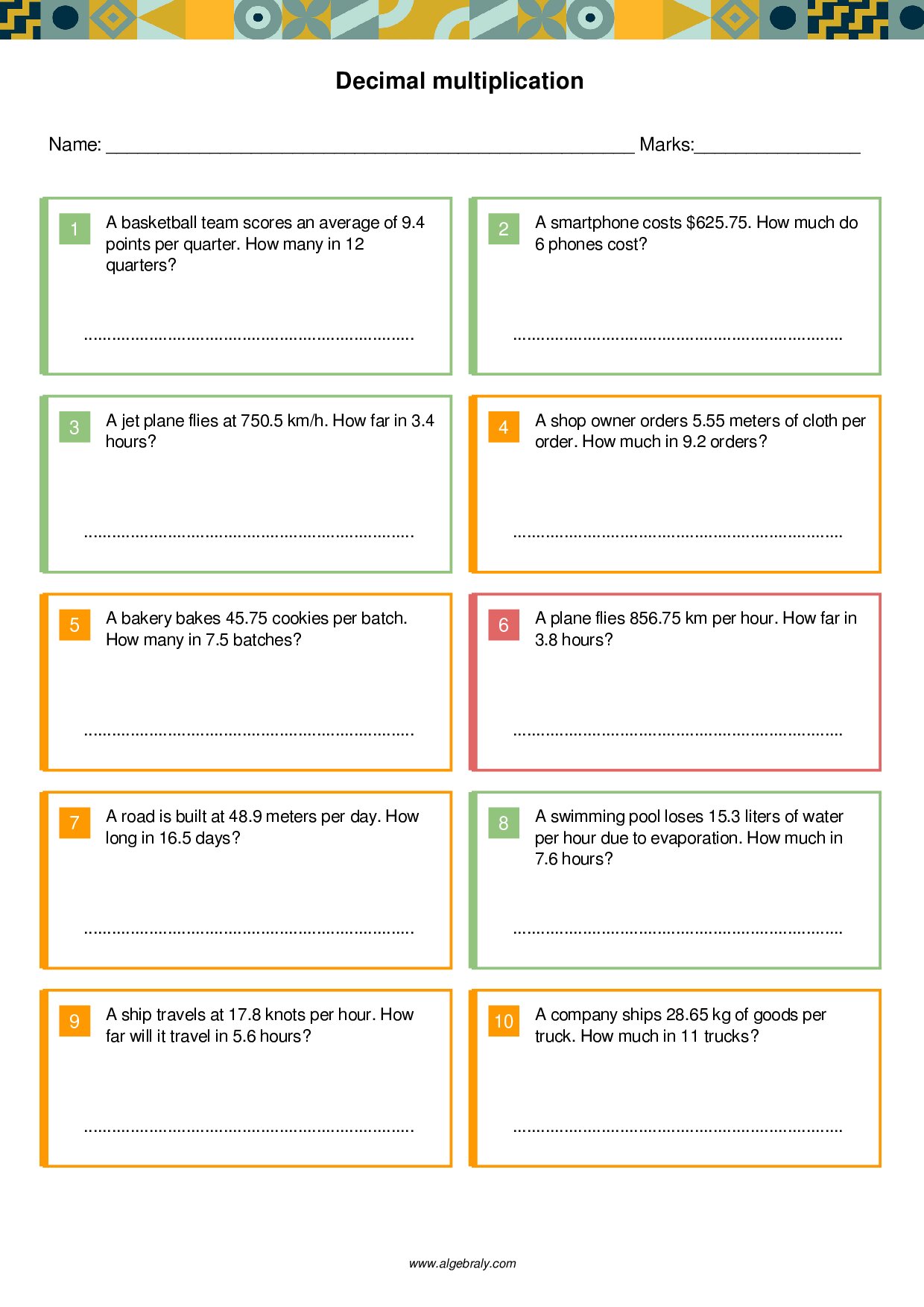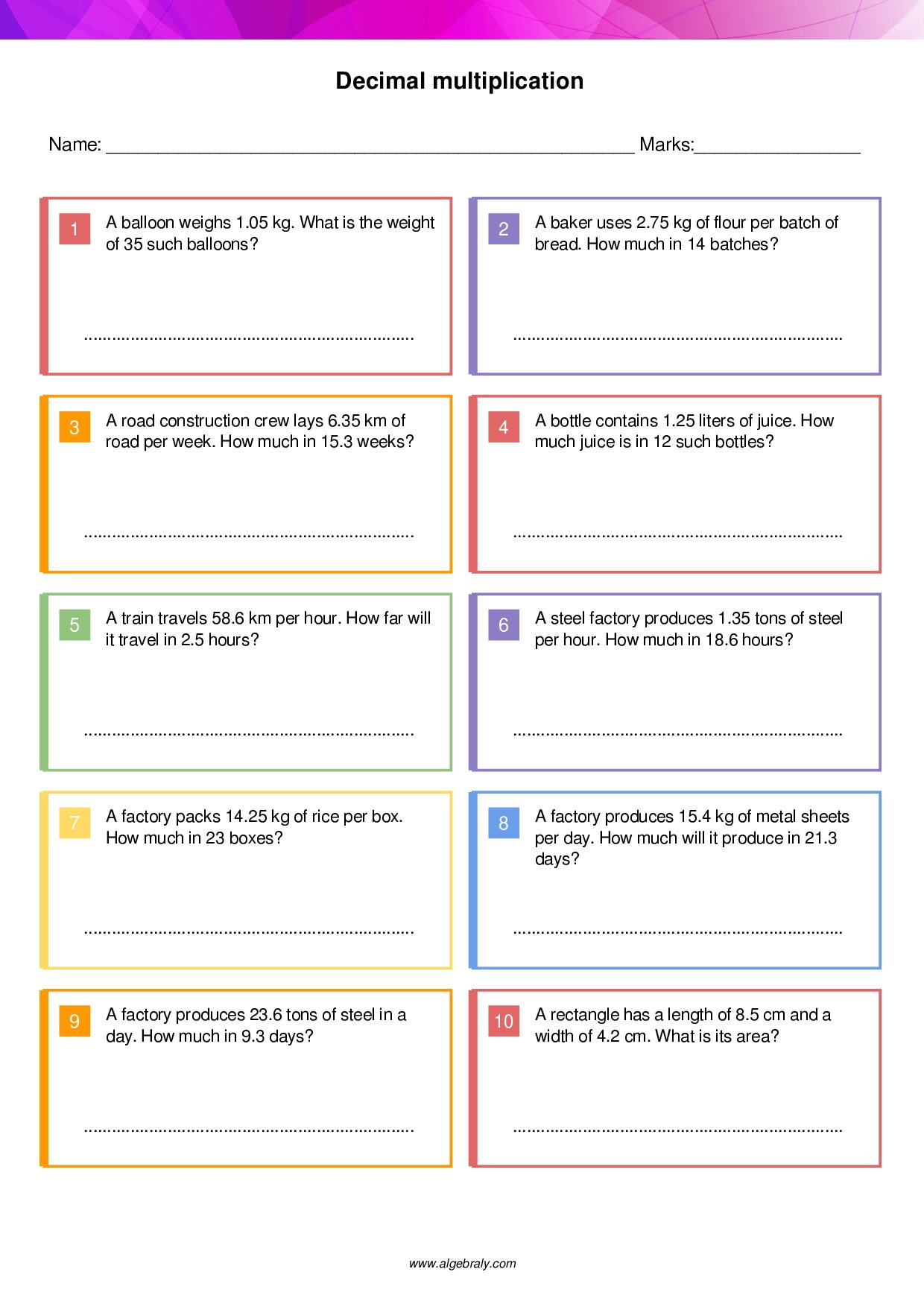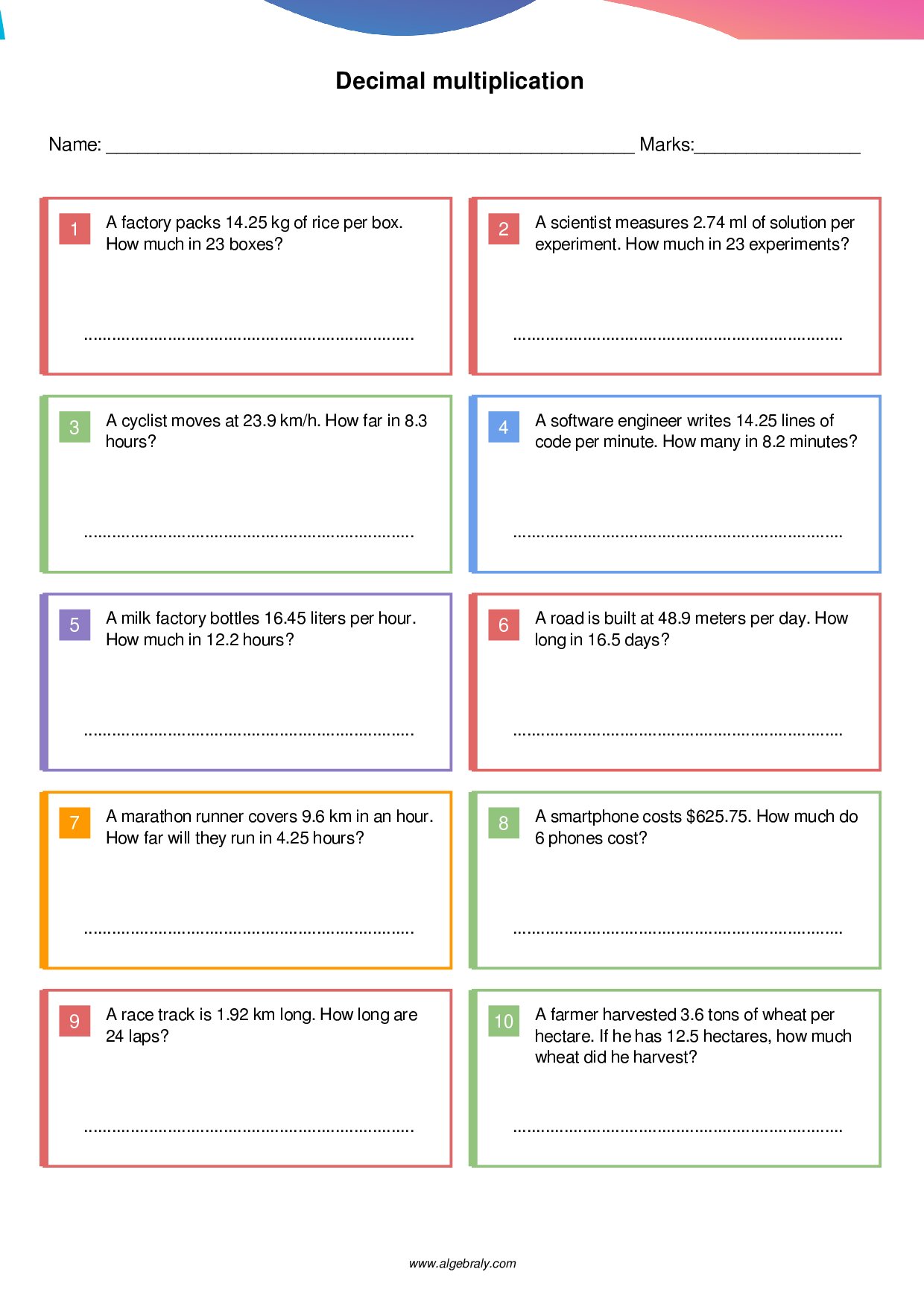Dynamically Generated Decimal Multiplication Worksheet
Decimal Multiplication Quiz – Word Problems
A plane flies 6.75 miles per minute. How far does it travel in 12.4 minutes?
Are you looking for an effective way to help your child or students to master decimal multiplication? This decimal multiplication worksheet collection offers a variety of engaging, real-world word problems that designed to enhance mathematical thinking. These each worksheet contains 15 decimal multiplication word problems with mix of easy, medium, and complex questions to provide a well-rounded learning experience. The worksheets are downloadable as PDFs, making them perfect for printing and classroom use.
Beyond worksheets, students can also test their skills with an interactive online decimal multiplication quiz. The online quiz/test is prepared to reinforce problem-solving abilities and build confidence in pre-algebra concepts. Whether used in a classroom or for independent study, these worksheets and quizzes focus on critical skills, including decimal multiplication, multi-step problem solving, financial math, measurement, and data analysis.
Your child/students will improve their ability to apply decimals in real-world sutuations such as money, distances, and unit conversions with these decimal multiplication worksheets. The dynamic worksheet generator allows for endless practice, ensuring that learners never run out of fresh problems. Teachers and parents can rely on these resources to help students build a solid foundation in decimal multiplication while developing critical thinking and problem-solving skills.
Download a decimal multiplication worksheet PDF today or take the online quiz to sharpen math skills in a fun and interactive way!
Skills Focused: Decimal Multiplication, Real-World Applications, Multi-Step Problem Solving, Measurement and Unit Conversion, Financial and Business Math, Data Interpretation and Analysis, Problem-Solving, Critical Thinking
How to Solve a Decimal Multiplication Word Problem
Emily buys 3.75 pounds of apples, and each pound costs $2.40. How much does she pay in total?
Time needed: 2 minutes
Learn how to solve a decimal multiplication problem involving real-world scenarios.
- Identify the Given Values
Emily buys 3.75 pounds of apples at $2.40 per pound. Find the total cost.
- Set Up the Multiplication Equation
Multiply 3.75 by 2.40 to find the total cost.
- Ignore the Decimals and Multiply as Whole Numbers
Convert 3.75 and 2.40 into whole numbers (375 and 240) and multiply: 375 × 240 = 90000.
- Adjust for Decimal Places
Since there are four decimal places in total (two in 3.75 and two in 2.40), place the decimal four places from the right in the result.
- Find the Final Answer
The correct answer is $9.00.
Learn More about Decimal Multiplication - Frequently Asked Questions
How do you multiply decimals step by step?
Multiplying decimals is also just like multiplying whole numbers, but you need to adjust for the decimal places at the end. First, forget the decimals and multiply the numbers as if they were whole. Then, count the total number of decimal places in both original numbers and place the decimal in the final product accordingly.
Why is multiplying decimals important?
Multiplying decimals is important for real-world applications like handling money, measuring distances, calculating ingredient amounts in recipes, and solving business-related math problems. It helps develop precision and accuracy in everyday calculations.
What are some common mistakes when multiplying decimals?
One of the most common mistakes is misplacing the decimal in the final answer. Another is forgetting to count the correct number of decimal places. Some students also round numbers too early, which can lead to small errors in their answers.
How can I practice decimal multiplication effectively?
To practice effectively, work through a mix of real-world problems and straightforward numerical exercises. Use worksheets with word problems to apply the skill in context, and take online quizzes to test speed and accuracy.
What is the rule for placing the decimal in a product?
The rule is simple: count the total number of decimal places in the two numbers you’re multiplying, then move the decimal point in the final product to the left by that many places.
Can you multiply decimals without a calculator?
Yes! The key is to ignore the decimals at first, multiply the numbers as whole numbers, and then adjust the placement of the decimal in the final answer. With enough practice, you can do it quickly and accurately without a calculator.
How is decimal multiplication used in real life?
It’s used in shopping (calculating discounts and taxes), cooking (scaling recipes), construction (measuring materials), science (calculating measurements), and business (profit and loss calculations). Understanding decimal multiplication makes everyday tasks easier and more precise.
What is a trick to multiplying decimals faster?
A simple trick is to temporarily remove the decimals, perform the multiplication as if working with whole numbers, and then place the decimal back at the end. Also, practicing with powers of ten (e.g., multiplying by 0.1 or 10) helps improve speed and accuracy.
Why do we remove decimals before multiplying?
Removing decimals simplifies the multiplication process by allowing you to work with whole numbers. Once the multiplication is done, the decimal is placed back based on the number of decimal places in the original numbers.
How do you check your answer when multiplying decimals?
To check your answer, estimate by rounding the numbers to the nearest whole number and multiplying them. If your final answer is close to your estimate, it’s likely correct. You can also reverse the operation using division to verify.
What are some real-world examples of decimal multiplication?
Real-world examples include calculating grocery bills with tax, determining fuel costs based on price per gallon, adjusting ingredient measurements in a recipe, and computing pay based on hourly wages with decimal fractions of an hour.
How do you multiply a decimal by a whole number?
To multiply a decimal by a whole number, ignore the decimal at first and multiply the numbers as if they were whole. Then, place the decimal in the result, matching the number of decimal places in the original decimal number.
What is the difference between multiplying and dividing decimals?
When multiplying decimals, you count the total decimal places in both numbers and adjust the final answer accordingly. In division, you may need to move the decimal point to turn the divisor into a whole number before proceeding with standard division.
How do you multiply decimals by powers of ten?
When multiplying by 10, 100, or 1,000, simply move the decimal point to the right by the number of zeros in the power of ten. For example, multiplying 4.56 by 100 shifts the decimal two places, resulting in 456.
What grade level typically learns decimal multiplication?
Decimal multiplication is usually introduced in 4th or 5th grade, with more complex applications appearing in middle school. It’s a key skill in pre-algebra and used frequently in higher-level math and real-life applications.





